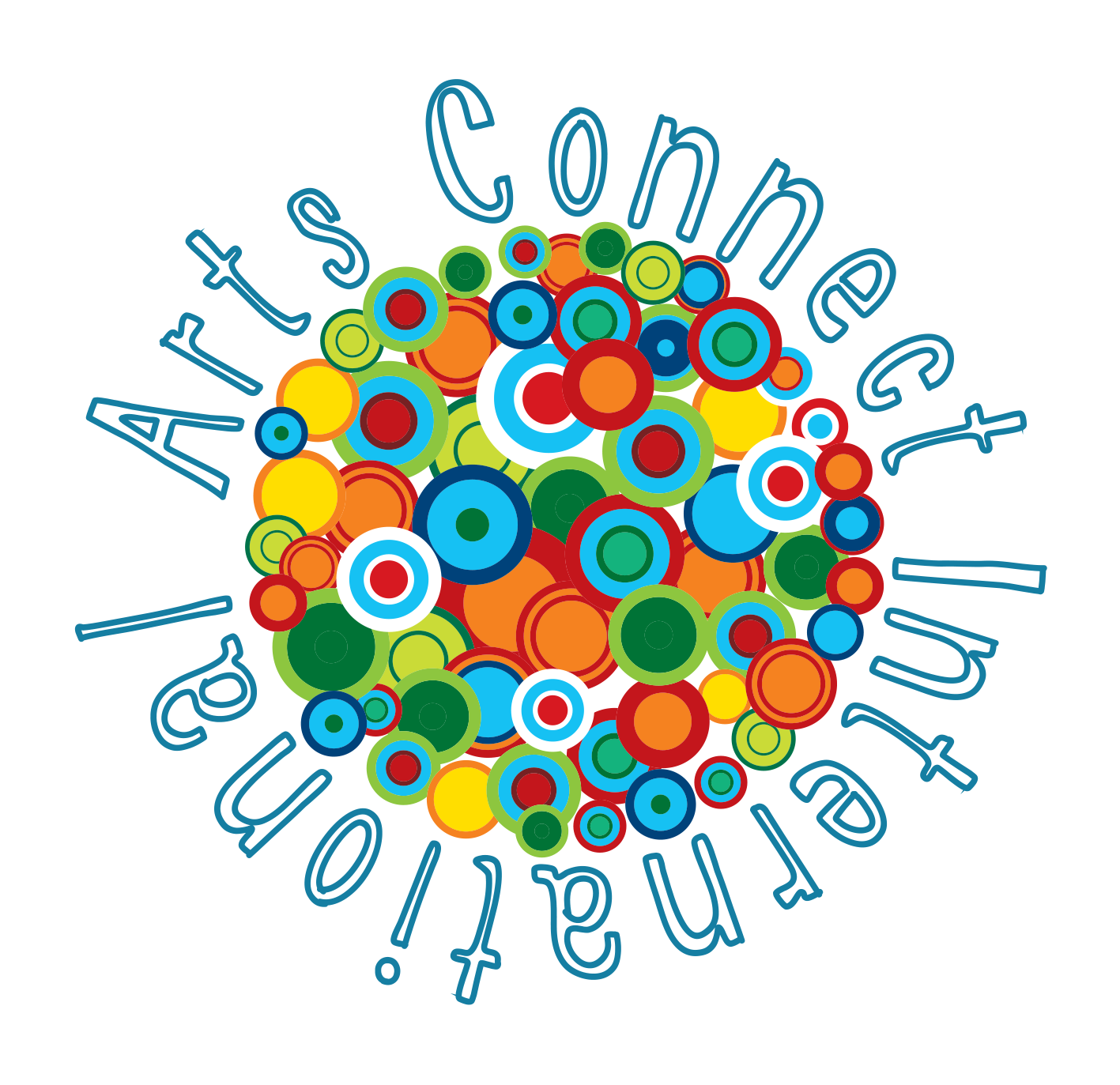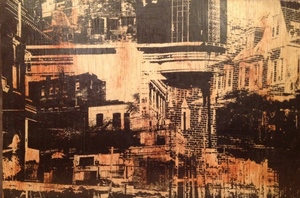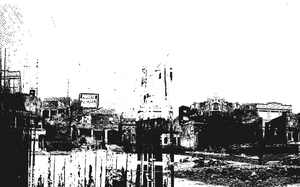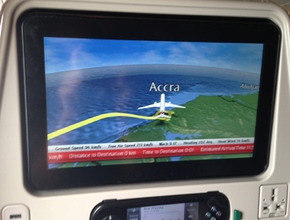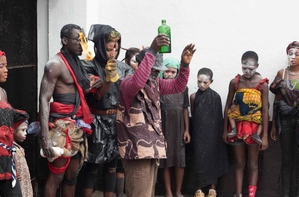ACI ARTIST LEADER BASIL KINCAID
International Residency: Accra, Ghana
National Residency: St. Louis, USA
This all feels sort of like a dream, dreams waking into dreams, prayers waking into prayers, dreams of prayers coming true. When I was selected as the inaugural Artist-in-Residence for ACI it didn’t feel real. I remember thinking to myself that it will feel real when I buy my plane ticket, or when I’m in training.
Then the day came when I bought my ticket, and surprisingly, it didn’t have that tinge or tint of reality that I imagined accompanying the act. I got to Boston and training went by so fast with such alacrity that I didn’t feel like I had time to process it while it was happening. I was so in the moment, so trapped in the present, that it too felt as a dream with its own lighting and character.
Then the time came for me to depart, my flight departed at 11pm- 11:23pm, to be precise. I spent the day drawing with friends, listening to music. That day was truly lovely- still a dream within a dream. As if my waking slumber was taking form, standing between mirrors positioned to face one another. We sat there drawing each other at the same time, both pretending in fleeting moments that we were not in fact looking at each other.
You drew in my book as I drew in yours, as if a character in your dream took time to scribe the memory of that reverie for you in its unfolding. We passed the time over tea, nervousness and excitement growing in my belly, walking its way up my throat as I swallowed what felt like rocks, little crystals of mystery as I face the unknown.
Then its time to go, I check my bags and run, literally run, to my gate. Arriving at the last second, I was just able to board my flight to Dubai. The experience was reminiscent to when I journeyed to Spain years ago, with the exception that I wasn’t alone, we all ran.
Now it is my time to embark on a creative journey of my own; with God and the love of the universe as my guide and companions. I’m a ball of energy, sweat and nerves. I can’t sit still so I take a little jaunt to the airport bar for a snack. Luckily it’s right by my gate. Thirty-two hours, with one layover in Dubai, and I find myself landing in Ghana. I collect my bags and immediately notice the sweltering heat.
It wasn’t until I met Serge (an artist I am collaborating with for Reclamation Ghana) and his cousins, who were all waiting at the exit of baggage claim and customs, that it became real. Here the African sun reached out to me, its unique sensation engulfing me. I could feel the melanin in my skin awakening as if the kiss of that sun was from a great grandmother that I hadn’t seen in far too long.
It has been hundreds of years… and however many lifetimes, since I was taken from this place. Kidnapped, enslaved, tortured- to now return, to finally be home. A home whose memory was like a lost dream that floods back to the forefront of the mind, a rogue scent that triggers a chain of neural reactions, awakening dormant records and emotions. I could cry when Serge opens his arms to embrace me.
I see that he came with several cousins and rented out a trotro bus for us and for my bags. I feel like we are brothers separated at birth, one shipped to a foreign land to grow under a different tongue. Living in Ghana has been surreal- the hospitality and warmth of people is simply amazing. I am in love with every bit of the Ghana that I have seen so far. We really hit the ground running too.
Serge introduced me to his performance art group GoLokal, a group centered on thinking globally and acting locally to address cross-cultural issues that face his community. The group focuses on direct engagement with the community through street performances, and has recently been asked to do performances for music videos and stage performances in collaboration with musicians of various kinds. I have been blessed enough to participate in both of these events.
The first performance I participated in was in collaboration with a local musician and video production company, performing in a music video that centered on contemporary fashion in Ghana. Our conceptual focus was to use found materials and second hand materials to make fashion forward costumes that could be replicated by the public inexpensively- shifting the trend in fashion to make it more accessible to the public.
The music video will be aired in Ghana and the UK, and will be featured in a Swedish Documentary on African Art entitled Afropedia.
A large focus for me right now is on getting to know this place and the people that I am surrounded by. Before I am able to be an effective and active member of the community, and harmoniously make art with my community here, I first need to understand the motivations and ideas of its people. I need to understand from a culturally contextualized perspective what matters to this community.
One thing that I am cognizant of not doing is imposing on the community. I want my work; and myself, to naturally find its (and my) place. In order for the work to succeed it must be both inspired and welcomed by the environment. It is vital to take time to absorb and be influenced by the place and the people before I try to reclaim. In all honesty you cannot actually reclaim something that isn’t yours.
It has been really informative to document Serge’s creative processes in creating his visual and sculptural works. I find that I have become really inspired by all of the colors and textures here. The textures and layers of color are so vibrant that I feel like I can taste them. I have also spent time photographing my surroundings. A large part of the first reclamation project included the integration of digital photographs of images taken from the location of focus, collaged into the found object work.
I use this process as a way to create new worlds from common images that I have taken from this world of our mutual creation. I am finding new ways to approach this concept and bridge the gap between traditional art forms and new media like digital collage. Digital collage is a process of taking digital photographs and manipulating them with programs like Photoshop or Illustrator into a new image that is comprised of several images. I use Illustrator for my digital collages manipulating the images to become black and white with no mid-tones, then as with traditional collage I cut and paste and overlap areas of the photographs to make new images.
I am so thankful for this opportunity. I feel it expanding my mind and my being every day. I am growing to realize the reality of privilege from the other side of the coin. Being here and being surrounded by black people is so empowering. Seeing black faces on the money, on tv, in the newspaper in advertisements, and most importantly, portrayed in positive light is tremendously healing for my spirit. This type of media portrayal is counter to most of the images seen in the United States, this with which I grew up.
In the United States the media portrayals of black men and of black people in general are generally negative and promptly followed by positive images of white people which builds this demonized perception of black people coupled with an exaggerated positive perception of white people. This discrepancy is also evidenced by the respective volume of the various imagery where our cultural importance lies. For a child to see one image of a black person preceded and followed by 10 images of white people gives the subconscious message to the child that white people are effectively 10 times more important. There was a study released by CNN that showed the effect that television has on the self-esteem of children providing evidenced to support the fact that the self-esteem of all children except for white boys is damaged by exposure to television, "TV can boost self-esteem of white boys".
I will write more on this empowerment in the upcoming months, but it is a full piece in and of itself. Long story short, I anticipate finishing this fellowship and coming back to my studio, community and practice in the United States with a wealth of insight, information and experience that will add depth to my work and strengthen my ability to be an artist leader and change agent within my community. I will be able to share of my experiences and break down many of the misconceptions that we are fed in the United States about what Africa is like. I will be able to share insight that will help people feel like I do, less alone, more connected to a rich history that goes much deeper and reaches centuries farther back that the way we are told our story in school, as if black history began with middle passage.
I find it imperative for people of all cultures; but especially for black people in the United States, to be able to connect with their roots and heritage because in our indoctrination and that of our ancestors there was a deliberate attempt to remove everything about our original cultures from our understanding of self, for this reason this necessity grows every day! The longer we stay blind to who we are and where we come from, the deeper we sink into confusion and disillusion about who we are. This is why there is a litany of media and literature resources too long to list on the nature and effects of the black identity crisis within the United States. This concept is true for all of us. The American Dream was not one conceived with the black community in mind; and thus we must dream our own dreams and define our own terms of success. As long as we allow others to define what it means to be successful we will never be “successful”, we will never be “enough”.
America’s definition of “success” and “enough” to date is defined by the dominant white community. We are in a place where academicians have said that as a nation we have transcended race. Nothing could be further removed from the truth when you look at the current unrest in America around human rights issues; specifically police brutality, equity in housing, and access to proper education and equality in the work place. As an artist I stand face to face with the harsh reality that only four percent of artists that make a functional living are black (Washington Post). This is just the surface of a much deeper and wider divide in access amongst social economic status and racial groups within our nation.
We, black Americas, will never be white, nor do I ever want to be white. I have stopped reaching for the acceptance of the majority- of white America, and ever since that day I have been all the better for it. Being black in America is tantamount to being wrong in America if you subscribe to all of the white American terms of acceptability.
As a black man growing up in St. Louis I know first-hand how the United States will make you feel sub-human and less than you are by virtue of your skin color. These racial divides and deconstruction of black America is in the news, it’s on TV, it’s in the fear I often meet through shifting eyes on the streets, it’s in the sound of car doors locking and double locking when you pass by, it’s in the way women tighten their grip on their purses, or go so far as to cross the street when you approach. This racial profiling and discrimination is everywhere in the United States, it is inescapable- it is enough to drive one mad.
James Baldwin said it best: “To be conscious and black in America is to be in a constant state of rage”. I hadn’t known how to break away from this rage until I came to Ghana. I am excited to document the effects that being here has on my work, and on my life as a black American, and global citizen, as I grow and move forward.
